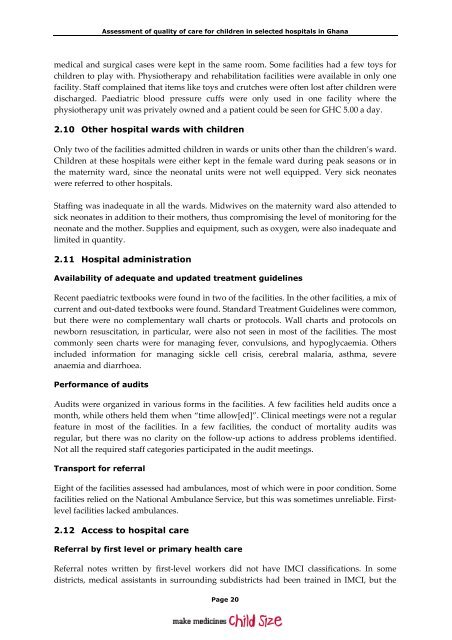Assessment of quality of care for children in selected hospitals in ...
Assessment of quality of care for children in selected hospitals in ...
Assessment of quality of care for children in selected hospitals in ...
You also want an ePaper? Increase the reach of your titles
YUMPU automatically turns print PDFs into web optimized ePapers that Google loves.
<strong>Assessment</strong> <strong>of</strong> <strong>quality</strong> <strong>of</strong> <strong>care</strong> <strong>for</strong> <strong>children</strong> <strong>in</strong> <strong>selected</strong> <strong>hospitals</strong> <strong>in</strong> Ghanamedical and surgical cases were kept <strong>in</strong> the same room. Some facilities had a few toys <strong>for</strong><strong>children</strong> to play with. Physiotherapy and rehabilitation facilities were available <strong>in</strong> only onefacility. Staff compla<strong>in</strong>ed that items like toys and crutches were <strong>of</strong>ten lost after <strong>children</strong> weredischarged. Paediatric blood pressure cuffs were only used <strong>in</strong> one facility where thephysiotherapy unit was privately owned and a patient could be seen <strong>for</strong> GHC 5.00 a day.2.10 Other hospital wards with <strong>children</strong>Only two <strong>of</strong> the facilities admitted <strong>children</strong> <strong>in</strong> wards or units other than the <strong>children</strong>’s ward.Children at these <strong>hospitals</strong> were either kept <strong>in</strong> the female ward dur<strong>in</strong>g peak seasons or <strong>in</strong>the maternity ward, s<strong>in</strong>ce the neonatal units were not well equipped. Very sick neonateswere referred to other <strong>hospitals</strong>.Staff<strong>in</strong>g was <strong>in</strong>adequate <strong>in</strong> all the wards. Midwives on the maternity ward also attended tosick neonates <strong>in</strong> addition to their mothers, thus compromis<strong>in</strong>g the level <strong>of</strong> monitor<strong>in</strong>g <strong>for</strong> theneonate and the mother. Supplies and equipment, such as oxygen, were also <strong>in</strong>adequate andlimited <strong>in</strong> quantity.2.11 Hospital adm<strong>in</strong>istrationAvailability <strong>of</strong> adequate and updated treatment guidel<strong>in</strong>esRecent paediatric textbooks were found <strong>in</strong> two <strong>of</strong> the facilities. In the other facilities, a mix <strong>of</strong>current and out‐dated textbooks were found. Standard Treatment Guidel<strong>in</strong>es were common,but there were no complementary wall charts or protocols. Wall charts and protocols onnewborn resuscitation, <strong>in</strong> particular, were also not seen <strong>in</strong> most <strong>of</strong> the facilities. The mostcommonly seen charts were <strong>for</strong> manag<strong>in</strong>g fever, convulsions, and hypoglycaemia. Others<strong>in</strong>cluded <strong>in</strong><strong>for</strong>mation <strong>for</strong> manag<strong>in</strong>g sickle cell crisis, cerebral malaria, asthma, severeanaemia and diarrhoea.Per<strong>for</strong>mance <strong>of</strong> auditsAudits were organized <strong>in</strong> various <strong>for</strong>ms <strong>in</strong> the facilities. A few facilities held audits once amonth, while others held them when “time allow[ed]”. Cl<strong>in</strong>ical meet<strong>in</strong>gs were not a regularfeature <strong>in</strong> most <strong>of</strong> the facilities. In a few facilities, the conduct <strong>of</strong> mortality audits wasregular, but there was no clarity on the follow‐up actions to address problems identified.Not all the required staff categories participated <strong>in</strong> the audit meet<strong>in</strong>gs.Transport <strong>for</strong> referralEight <strong>of</strong> the facilities assessed had ambulances, most <strong>of</strong> which were <strong>in</strong> poor condition. Somefacilities relied on the National Ambulance Service, but this was sometimes unreliable. Firstlevelfacilities lacked ambulances.2.12 Access to hospital <strong>care</strong>Referral by first level or primary health <strong>care</strong>Referral notes written by first‐level workers did not have IMCI classifications. In somedistricts, medical assistants <strong>in</strong> surround<strong>in</strong>g subdistricts had been tra<strong>in</strong>ed <strong>in</strong> IMCI, but thePage 20
















